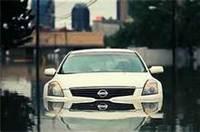AAA Chicago: Steps to Take in a Flood
 |
AURORA, IL--April 18, 2013: Flooding can create extremely dangerous driving conditions for motorists on roadways. AAA Chicago advises motorists to prepare themselves and their car. Motorists are advised to monitor weather conditions and follow advice from authorities. If it is not safe to travel and you don't have to travel, don't drive.
AAA's Emergency Services are also seeing extremely high call volumes. We are prioritizing emergency calls and are asking those whose cars are stranded in water to call us back once water has subsided and we will rescue cars then. Our priority is helping those people in a dangerous situation or in an emergency.
In the wake of today's weather, AAA Chicago advises the following information for those driving through flooded areas:
Flood Damaged Vehicles- What to Do Next
Vehicle flooding often results in difficult and expensive repairs. To avoid causing additional problems, AAA advises motorists to observe these "What to Do If.." guidelines when dealing with a flooded vehicle.
What to Do If my vehicle is currently in standing water:
Do not attempt to start a vehicle in standing water unless the water
level is below the door openings and never rose any higher than the door
opening. Trying to start a vehicle that is currently, or was previously
exposed to higher water levels could result in immediate and severe engine
damage if water is drawn into the combustion chambers.
What to do if the water level never rose above the door openings and
the interior of my vehicle is dry:
Most vehicles in this situation can be started and driven safely.
However, it is a good idea to have the undercarriage washed to remove any
storm debris, including dirt, salt and other contaminants that might have
been in the floodwater. You may also want to have a qualified repair
facility inspect the brakes and any other mechanical or electrical
components that were partially or completely submerged.
What to do if the water level rose above the door openings and the
interior of my vehicle is wet:
Once the interior of a vehicle has been exposed to water contamination,
AAA recommends the car not be started until a thorough professional
inspection and cleaning has been performed. In general, the higher the
water level rose, the greater the potential for flood-related problems.
Examples of damage include:
- Cosmetic damage to upholstery and carpeting
- Long-term rust and mold development if the vehicle interior is not thoroughly dried
- Health concerns from sewage or other toxic substances in the flood water
- Short-term electrical/electronic component failure due to flooding
- Computers, sensors, instruments, entertainment/navigation systems, etc.
- Long-term electrical/electronic issues due to the corrosion or oxidation of components and connectors from residual moisture
- Mechanical component damage or accelerated wear due to water entry or
fluid contamination
- Engine, transmission, final drive/differential, fuel system, brake system, power steering system, etc.
Before attempting to start a flood-damaged car, an owner or qualified technician should:
- Inspect all mechanical components and systems that contain fluids for water contamination
- Drain floodwater from contaminated components and systems, then flush and refill with new clean fluids of the proper types
- Inspect, clean, and dry all electrical system components and connections
How to Spot a Flood Damaged Vehicle in Your Area
AAA warns car buyers that flood-damaged vehicles can be shipped anywhere for resale, and may show up for sale as early as one week after a devastating storm throughout the U.S. These vehicles can continue to appear in the marketplace for up to a year after a major flood. Due to the short time period between the water damage and being sold, often these vehicles are not identified as flood-damaged in national databases.
Whether you are shopping for a new vehicle from a dealer or are a used one from any source, AAA offers these tips:
How to Spot a Flood-Damaged Vehicle
- Engage your sense of smell to detect any damp or musty odors inside the vehicle.
- Are the windows fogged up? Has the carpet or upholstery been replaced or recently shampooed? Pull back the carpet at different areas and look for mud, dirt or signs of water stains.
- Inspect the dashboard underside for signs of mud and dirt. This is a particularly hard area to clean.
- Look under the vehicle for corrosion. It is uncommon to find corrosion in newer vehicles and those that are owned or sold in southern states.
- Open all doors, hood, and trunk to inspect for corrosion, mud and dirt or discoloration on the door frames, hinges and under the weather stripping. Pay special attention to small spaces and crevices that are difficult to clean.
- Check all warning lights, window motors, and all electrical components to ensure they are working properly. While a non-working part alone does not mean the vehicle was flooded, it combined with other difficulties is a cause for concern.
- Obtain a CARFAX Vehicle History Report. This report can potentially reveal if the vehicle has been involved in a flood, major accident, fire, or uncover odometer fraud.
- Always have the vehicle inspected by a quality repair facility prior to purchasing. AAA Approved Auto Repair facilities are located across the United States. Nearby locations can be found at AAA Repair .


